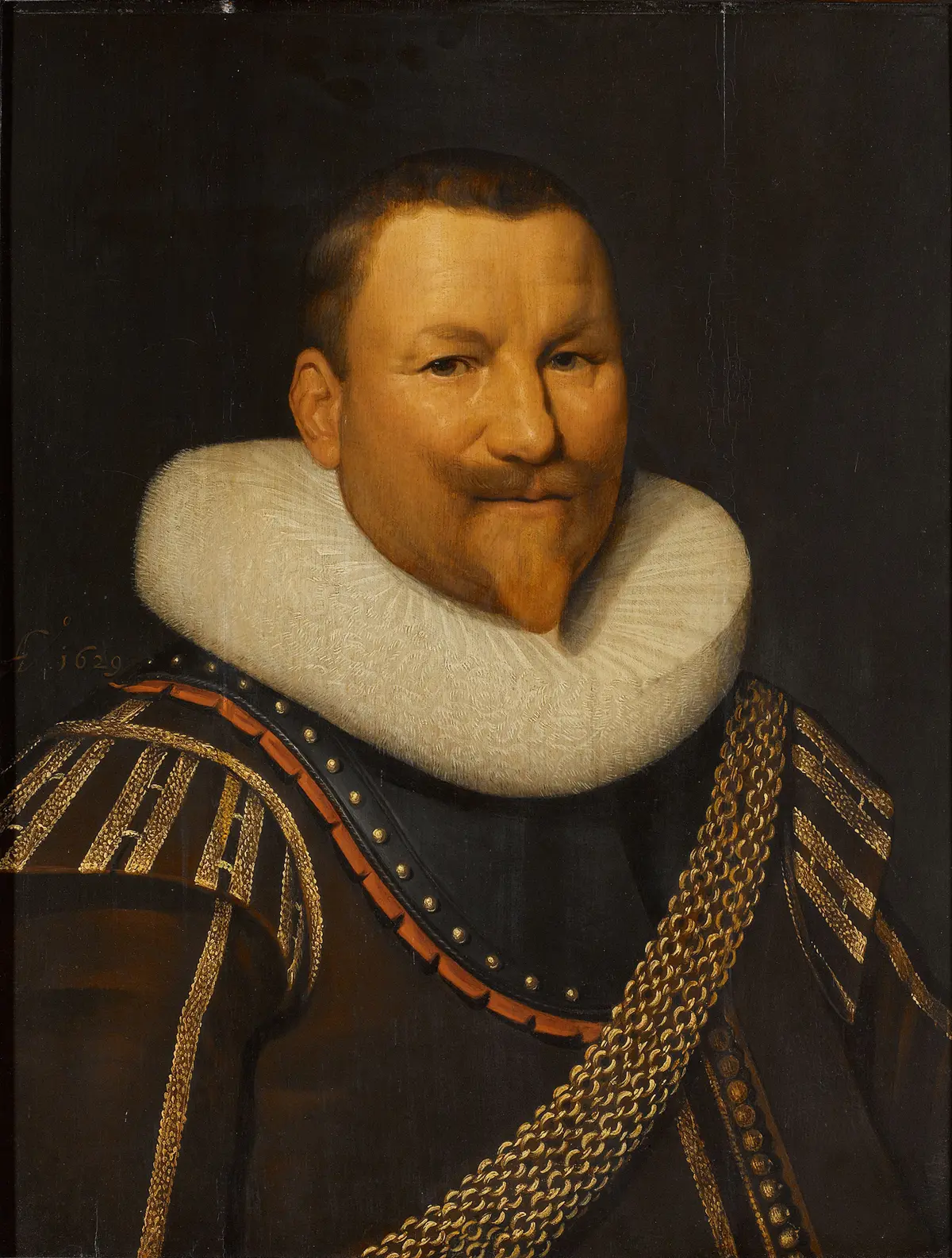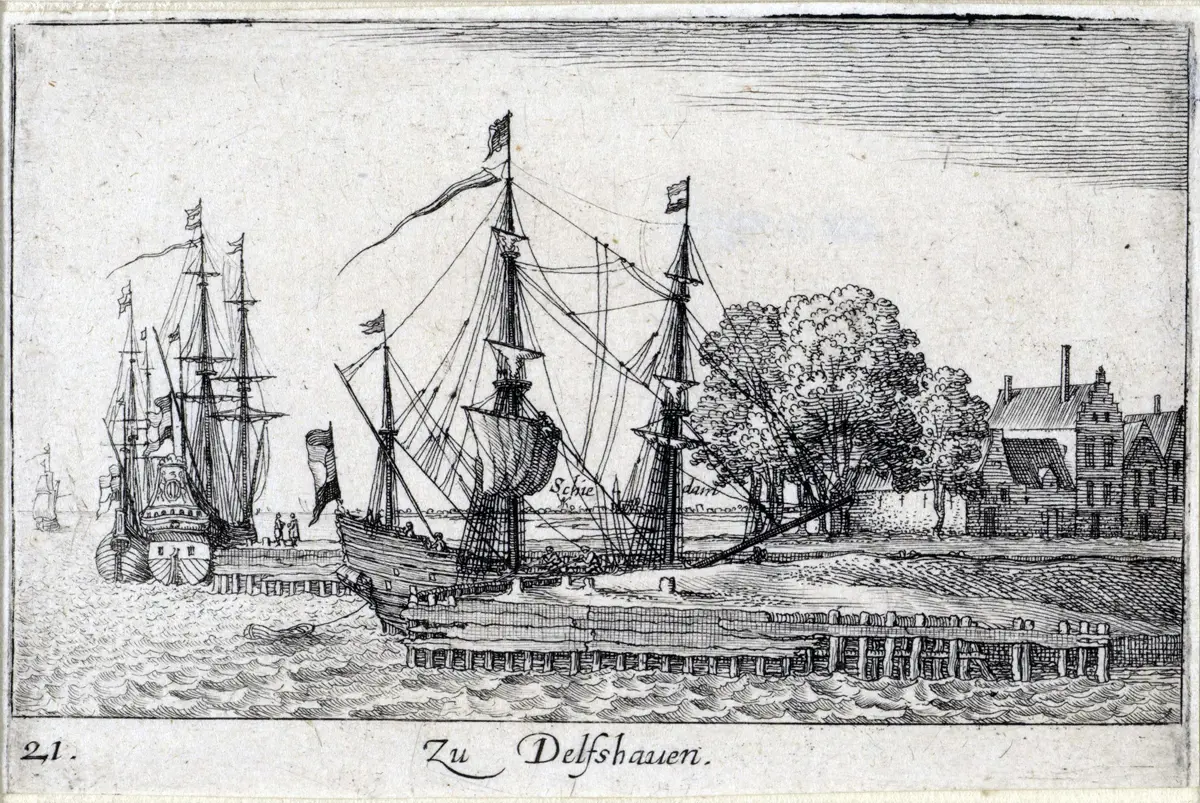Piet Hein: the death of a naval hero
Who was Piet Hein?
Piet Hein was born in 1577 in Delfshaven, the former harbour of Delft (now part of Rotterdam). He called it a true “seaside town” because it primarily thrived on herring fishing. Piet was introduced to seafaring from a young age: after completing elementary school, he learned the trade from his father, who worked as a skipper and later a captain for Delft merchants, fishing for herring and trading with countries around the Baltic Sea. These two sectors were crucial sources of income for the new Dutch Republic. Maritime trade was of paramount importance, as was the protection of ships involved in overseas trade of goods.

Sailing at sea was neither safe nor comfortable. On board, clean drinking water and fresh food were not always accessible, leading to diseases such as scurvy and typhus claiming lives during the journeys. Rats and fleas were common, and at times, the smell was unbearable. The crew, consisting of rugged individuals, could be away from home for months or even years depending on the destination. Sailors could mutiny, face the risk of drowning, perish in a battle, or be captured. Piet Hein himself was a prisoner on multiple occasions and had to row as a galley slave for the Spaniards (see timeline).
Piet Hein had a brief but eventful career at sea. From 1607 to 1612, he served the Dutch East India Company (VOC) and sailed with their fleet to various destinations, including Indonesia. After the establishment of the Dutch West India Company (WIC), he served as a vice admiral from 1623 to 1627, undertaking voyages to Brazil, Angola, and the Caribbean. He was granted letters of marque by the government, officially allowing him to engage in naval warfare. Among his contemporaries, Piet Hein stood out for his strong leadership at sea, his courage, and craftsmanship. He was a skilled navigator, employing various maritime tricks that required extensive knowledge. Reading and understanding the sea was crucial to ensure his ships were not carried away by currents or adverse weather conditions. Hein was adept at calculations, determining his position at sea using a compass, quadrant (a sundial-shaped instrument to measure the altitude of the sun above the horizon), and a Jacob's staff (a measuring rod to determine latitude). Navigating required knowledge of astronomy and map reading. In addition to these skills, he had to effectively manage the crew, and possess expertise in combat techniques. Loading and firing one cannon took eight men approximately eight minutes! Hence, in battle, timing and the positioning of the crew and ship were crucial. Piet Hein proved to be a leader who maintained order, created loyal crews, and conducted himself honourably.
Hein's capture of the coastal town São Salvador in the Brazilian All Saints' Bay in 1624 brought him initial recognition. However, he gained true fame through his conquest of a Spanish silver fleet near Cuba four years later. This conquest was significant because silver was the core of the global economy, used to mint currency for trade and financing wars. Almost all the silver mined in the 17th century came from Central and South America, then under the control of the Spanish Empire. In addition to silver, the fleet carried gold, hides, amber, silk, sugar, and expensive dyes like indigo and cochineal. For the Spaniards, the loss of their silver fleet was a massive financial blow. The Dutch Republic gained an enormous amount of wealth and treasures from this conquest, estimated to be worth over 11 million guilders (approximately one billion euros today). Hein himself did not become significantly richer; he received a modest bonus and a gold chain with a medal.
The most famous song about the silver fleet dates back to the 19th century. We might still know part of it today:
Piet Hein, Piet Hein, Piet Hein, his name is short,
His deeds are great, his deeds are great.
He won the silver fleet.
He won, won the silver fleet,
He won, won the silver fleet.
The conquest of the silver fleet was so crucial for the country's government and the directors of the West India Company (WIC) that Piet Hein was hailed as a hero. He himself was somewhat surprised, as the operation had been relatively easy, and he considered his other performances, such as in All Saints' Bay, to be much more heroic. He wouldn't have much time to dwell on it, though. A year after seizing the silver fleet, he was appointed lieutenant admiral and embarked on his final expedition. In 1629, he met his end in an inconspicuous skirmish with Dunkirk privateers near Calais.
Piet Hein received a solemn state funeral in the city of Delft, following the same protocol as Prince Maurits' funeral, highlighting the significance the government attached to him at that moment. A massive procession moved from Hein's house through the city towards the Oude Kerk. Leading the way were two companies of the Delft civic guard in mourning attire. Sea captains followed, carrying Hein's armour, sword, helmet, gloves, spurs, and command staff. Three flags from the captured Spanish ships and the family coat of arms preceded the coffin. Family and official representatives followed behind. In total, over a thousand individuals participated in the procession. Hein's wife had to stay home as, according to 17th century customs, women were not allowed at funerals. In the Oude Kerk, Hein's remains were buried in the high choir, where later a funerary monument would be erected.
Piet Hein: the death of a naval hero

Who was Piet Hein?
Piet Hein was born in 1577 in Delfshaven, the former harbour of Delft (now part of Rotterdam). He called it a true “seaside town” because it primarily thrived on herring fishing.

The monument for Piet Hein
Shortly after Hein's death in 1629, the government decided that the Admiralty of Rotterdam (one of the five authorities organizing the navy) should commission a monument for him.

A controversial past
Many people associate Piet Hein with slavery because he worked for the VOC and WIC. These institutions indeed engaged in the trading of enslaved individuals, but this occurred after Hein's death.

Piet Hein at sea
Among his contemporaries, Piet Hein stood out for his strong leadership at sea, his courage, and craftsmanship.

Piet Hein - Symphonische Rock Versie
Je kent vast het bekende liedje van Piet Hein. Maar hoe zou datzelfde liedje klinken in een hele andere stijl? Bijvoorbeeld in een nogal bombastische symphonische rock versie. Luister maar!

Piet Hein - Hiphop Versie
Je kent vast het bekende liedje van Piet Hein. Maar hoe zou datzelfde liedje klinken in een hele andere stijl? Bijvoorbeeld in een vrolijke old-skool hiphop versie. Luister maar!

Piet Hein - Zeemanslied
Je kent vast het bekende liedje van Piet Hein. Maar hoe zou datzelfde liedje klinken in een hele andere stijl? Bijvoorbeeld als een zeemanslied. Luister maar!

Piet Hein - Oratorium
Je kent vast het bekende liedje van Piet Hein. Maar hoe zou datzelfde liedje klinken in een hele andere stijl? Bijvoorbeeld als oratorium. Luister maar!

Piet Hein - Swing
Je kent vast het bekende liedje van Piet Hein. Maar hoe zou datzelfde liedje klinken in een hele andere stijl? Bijvoorbeeld in swing style. Luister maar!

Glossy Piet Hein: de disclaimer
Naar aanleiding van de expositie Piet Hein: de dood van een zeeheld en de koppeling met het herdenkingsjaar slavernijverleden heeft de Oude en Nieuwe Kerk een glossy uitgebracht over het leven van Piet Hein en wat voor invloed onze geschiedenis heeft op het leven van vandaag.
